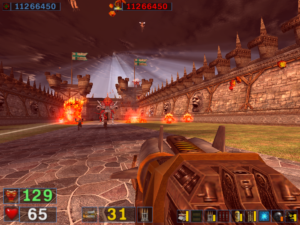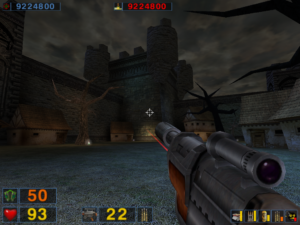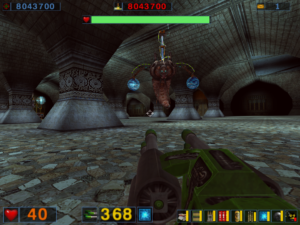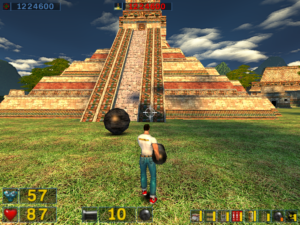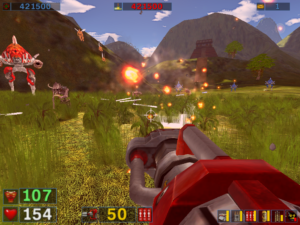SS2E: The End
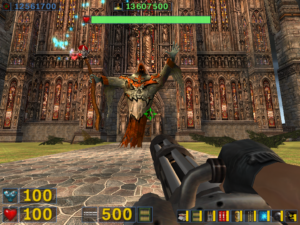 It turns out that the final levels shed the halloween motif pretty quickly and settle into something more like the knightly stuff I was expecting. Not that this has a very great effect on on the game — the monsters are the same as always, and not even reskinned. But the ultimate goal is the Holy Grail (which helps you get a spaceship somehow), and the final boss is a gray-robed wizard-looking guy, albeit one who’s 80 feet tall according to the stats provided in-game. His schtick is that he summons random assortments of the standard monsters, which makes for a difficult fight until you find out about the cheap trick that lets you take him down with near absolute safety. Something of a letdown, but then, the end boss in Serious Sam: The First Encounter is a really tough act to follow.
It turns out that the final levels shed the halloween motif pretty quickly and settle into something more like the knightly stuff I was expecting. Not that this has a very great effect on on the game — the monsters are the same as always, and not even reskinned. But the ultimate goal is the Holy Grail (which helps you get a spaceship somehow), and the final boss is a gray-robed wizard-looking guy, albeit one who’s 80 feet tall according to the stats provided in-game. His schtick is that he summons random assortments of the standard monsters, which makes for a difficult fight until you find out about the cheap trick that lets you take him down with near absolute safety. Something of a letdown, but then, the end boss in Serious Sam: The First Encounter is a really tough act to follow.
Looking back on the whole game, how would I describe it? Oddly medatative. The bulk of the player’s time is spent on chaotic battles in open areas, which is the kind of action that mainly engages the lower brain functions, leaving the player’s thoughts free to wander. Sometimes this means I was thinking about tactics — deciding which weapon to use, whether to seek cover, and so forth — but by the end, I had pretty much got that down. There are only so many permutations the game supports, and by the end, you’ve seen them all several times. I suppose most FPSes deal with this by varying the environment a lot, adding in puzzles and platformer sections if necessary. But Sam, especially toward the end, mainly plays to its strength: chaotic battles in large, open environments.
So, do I want to continue on to Serious Sam 2? Maybe, eventually. There are other FPS games on the Stack, and a distinct possibility that I’ll be sick of them before I get through them all.
 Comments(1)
Comments(1)